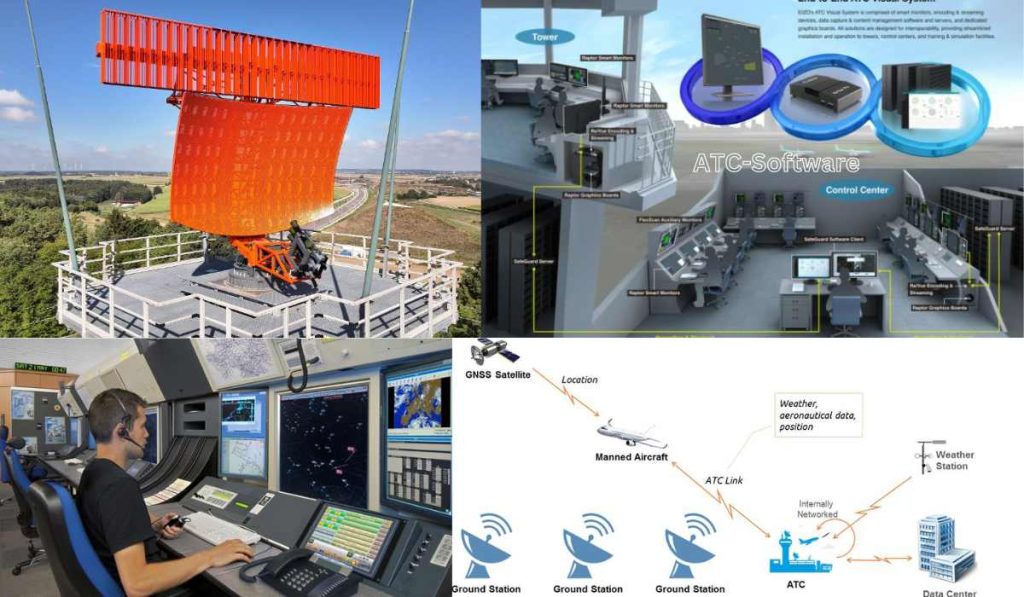Exploring Air Traffic Control Systems and Management in UK
The UK skies are a bustling ballet of behemoths. From sleek passenger jets to rumbling cargo haulers, a constant stream of aircraft crisscrosses the nation’s airspace. But ensuring this aerial choreography remains safe and efficient requires a complex orchestra behind the scenes: Air Traffic Control (ATC) Systems and Management.
In 2024, the UK’s ATC landscape is undergoing a fascinating metamorphosis. Legacy systems are being upgraded, cutting-edge technologies are taking flight, and a focus on environmental sustainability is gaining altitude. Let’s delve into the heart of UK Air Traffic Management (ATM) and explore the marvels that keep our skies safe and our flights on schedule.

Safety of Essential ATC Systems
Imagine a conductor wielding a baton, meticulously guiding an orchestra. In the world of ATC, the conductor’s role is played by a network of sophisticated systems working in harmony. Here are some key players:
- Air Traffic Management (ATM) Systems: The maestro of the operation, ATM systems provide air traffic controllers with a comprehensive picture of the airspace. These include:
- ATC Radar: The watchful eye in the sky, ATC radar paints a real-time picture of aircraft positions and movements.
- Voice Communication Switching Systems: The vital communication channel, these systems ensure crystal-clear voice communication between controllers and pilots.
- Air Traffic Control Simulators: Training grounds for future maestros, simulators replicate real-world scenarios, honing the skills of air traffic controllers.
- ATC Displays: The controller’s visual interface, ATC displays present critical information like aircraft positions, altitude, and speed.
- Air Traffic Control Automation: As technology evolves, automation plays an increasingly crucial role. Automated systems assist controllers in tasks like conflict detection and resolution, freeing them to focus on complex situations.
Mastering Air Traffic
The success of UK ATC hinges not just on technology but also on a deep understanding of airspace management. Here are some core concepts:
- Air Traffic Flow: Maintaining a smooth flow of air traffic is paramount. This involves techniques like separation standards (ensuring safe distances between aircraft) and sequencing (arranging the order of takeoffs and landings).
- Air Traffic Control Modernization: The UK is actively modernizing its ATC infrastructure. This includes initiatives like:
- NextGen ATM (Next Generation Air Traffic Management): A global initiative to improve efficiency, safety, and capacity of airspace.
- Digital ATC: Leveraging digital technologies for enhanced communication, data sharing, and decision-making.
- Trajectory-Based Operations (TBO): Optimizing flight paths for efficiency and reduced emissions.
- Air Traffic Controller Training: Highly skilled controllers are the backbone of the system. Rigorous training programs ensure they possess exceptional situational awareness, decision-making skills, and the ability to handle high-pressure situations.
Uniquely British
The UK’s ATC system boasts some distinct characteristics:
- Civil Aviation Authority (CAA): The CAA serves as the national aviation regulator, overseeing safety standards and airspace management.
- Air Traffic Management Bureau (ATMB): Within the CAA, the ATMB is responsible for developing and implementing national ATM strategies.
- CNS/ATM (Communication, Navigation, Surveillance/Air Traffic Management): A key focus in UK ATC is seamless integration of communication, navigation, and surveillance technologies for enhanced safety and efficiency.
Keeping Pace with the Skies
While the UK’s ATC system is a marvel of efficiency, it’s not without its challenges:
- Air Traffic Congestion (UK): As air travel continues to grow, airspace congestion remains a concern. Strategies like ATFM (Air Traffic Flow Management) are employed to optimize traffic flow and minimize delays.
- Drone Traffic Management (UK): The rise of drones presents new challenges for airspace management. The UK is actively developing regulations and systems to integrate drone traffic safely.
Soaring Towards a Sustainable Future
The future of UK ATC is not just about efficiency and safety, but also about sustainability. Here’s how the industry is taking flight:
- Sustainable Aviation: New technologies and operational procedures are being explored to reduce the environmental impact of aviation. This includes optimizing flight paths for fuel efficiency and utilizing cleaner-burning fuels.
- Airport Collaborative Decision Making (A-CDM): This collaborative approach optimizes airport operations, leading to reduced ground delays and ultimately, lower emissions.
The UK’s ATC system is a testament to human ingenuity and technological prowess. As the skies become more crowded and technology evolves, the UK is well-positioned.
Get a Quote from Top 12 Global Leader Air Traffic Control Systems Manufacturers
FAQs
What are some new technologies used in UK ATC?
Modern UK ATC utilizes advanced radar systems, digital communication platforms, and even automation to assist controllers. This allows for better situational awareness, faster response times, and improved traffic flow.
How is the UK preparing for future air traffic growth?
The UK is actively involved in NextGen ATM, a global initiative for efficient airspace management. This includes implementing digital ATC systems and optimizing flight paths for efficiency and reduced emissions.
Who oversees Air Traffic Control in the UK?
The Civil Aviation Authority (CAA) acts as the national regulator, setting safety standards and licensing controllers. The Air Traffic Management Bureau (ATMB) within the CAA develops national ATM strategies to ensure smooth and safe airspace operations.











